The California International Antiquarian Book Fair returns to San Francisco February 9-11. Widely recognized as one of the world's largest exhibitions of antiquarian books for sale, more than 100 exhibitors from around the world will present rare books, maps, illustrations, historical documents, and ephemera on a vast array of subjects and genres. Here is a small preview of the material exhibitors will have available.
THE UNIQUE ORIGINAL AMBROTYPE
Ostendorf #14. Housed in an 1865 period frame, with mourning ribbons setting off the ambrotype at the corners.
Cole, Roderick A. (attributed) Abraham Lincoln. Ninth-Plate Ruby Glass Ambrotype.
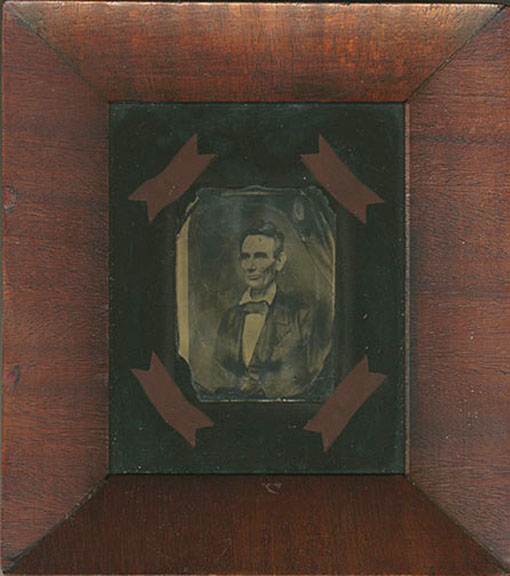
Peoria Illinois: circa 1858. Displayed in a plain, but handsome, period wooden frame with the back opened in order to observe the painted backing and the “ruby-red” tone.
Ambrotypes are negative images produced on a glass plate, viewed as a positive by the addition of a black backing; sometimes this backing is a piece of velvet and other times, such as the present one, a thin varnish. The ruby-red quality of the glass is quite apparent. 1856-1858 were the peak years of the ambrotype, into which this example falls. But just as the ambro was displacing the daguerreotype, the care-de-visite and the tintype were waiting in the wings, about to displace this technique.
The Cole image was popularized on campaign ribbons and button ferrotypes during the 1860 presidential campaign. Probably obtained during that campaign, kept in a drawer, and then, after the assassination, removed from the case and switched to this frame. Mourning ribbons were added and the whole reverently hung on the wall as a memorial to the fallen leader.
This image was a favorite of Mr. Lincoln, apparently giving a copy to his stepmother in 1861. This particular ambrotype was found in Allentown, Pa. in 1980.
Period copies of this image, in ambrotype form, appear infrequently on the market. BUT, they were each produced directly from this original, with the images always reversed. The present one is the actual glass through which the light photons passed that bounced off Lincoln himself! This is the third time our shop has handled this exciting find – exciting because original Lincoln ambrotypes are excessively scarce!
Offered by Abraham Lincoln Bookshop, booth 210.
Beautifully bound mid-17th-century “Visscher Edition” of the Dutch Luther Bible with expertly hand-colored and highlighted gold illustrations.
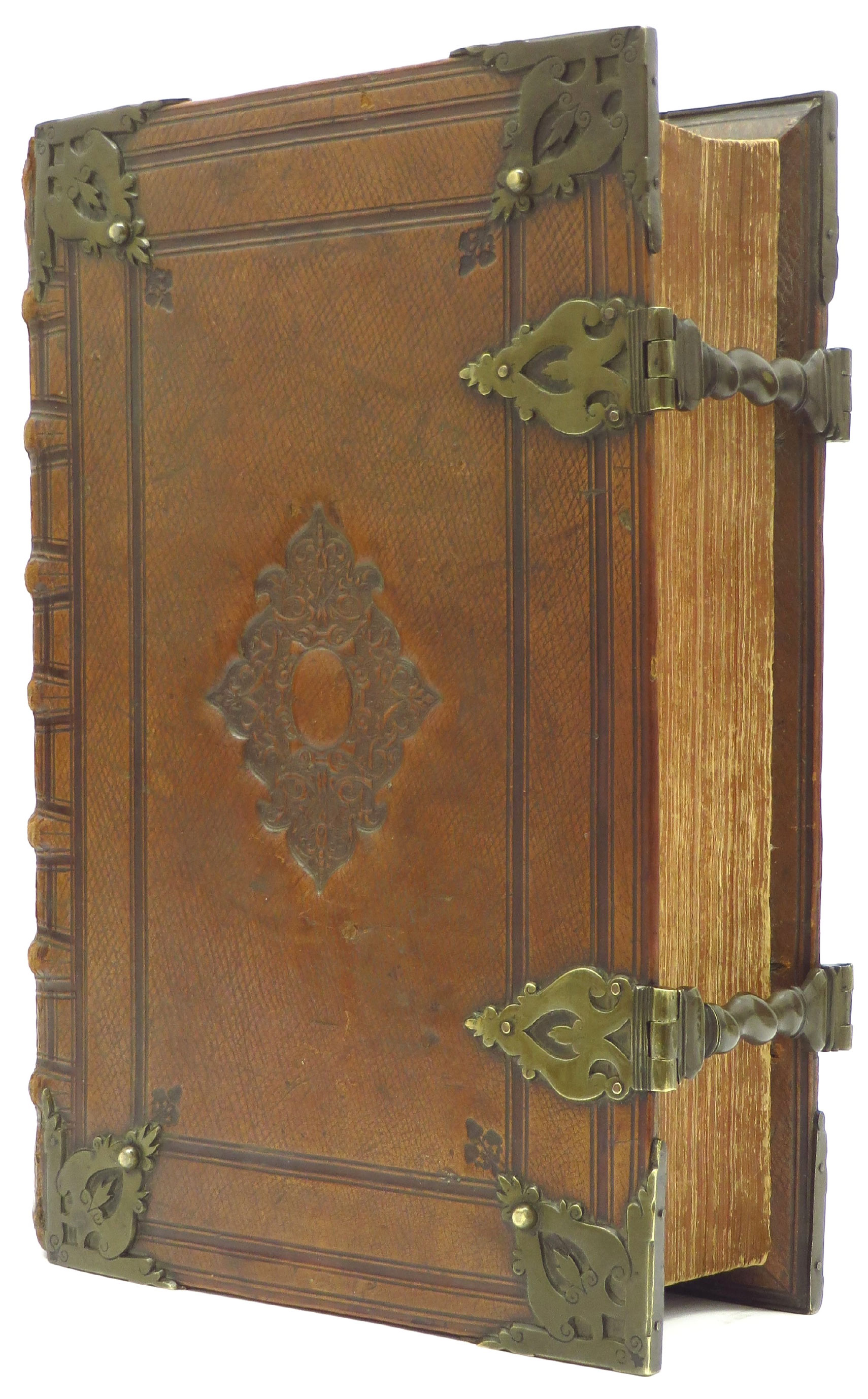
Publisher: Rieuwert Dircksz. Van Baardt (1599-1648)
Place: Amsterdam, 1648
Size: 38x27x11cm
Price: USD 48,500
Offered by Antiquariaat de Roo, booth 223.
Complete copy of the Fourth Folio edition of William Shakespeare’s works: Mr. William Shakespear's Comedies, Histories, and Tragedies. Published according to the true Original Copies. Unto which is added, Seven Plays, Never before Printed in Folio, published in 1685.

This is the last and most comprehensive edition of Shakespeare’s plays printed in the seventeenth century, with seven plays added for the first time, although of the seven only Pericles is now generally accepted as Shakespeare’s. Bennett’s copy may have belonged to one of Charles II's mistresses and is recently and handsomely bound by the distinguished California bookbinder Philip Dusel. It is priced $95,000.
Offered by Stuart Bennett Rare Books, booth 127.
The Beatles [Lyrics by Paul McCartney]
Handwritten Lyrics of "Lovely Rita, Meter Maid"
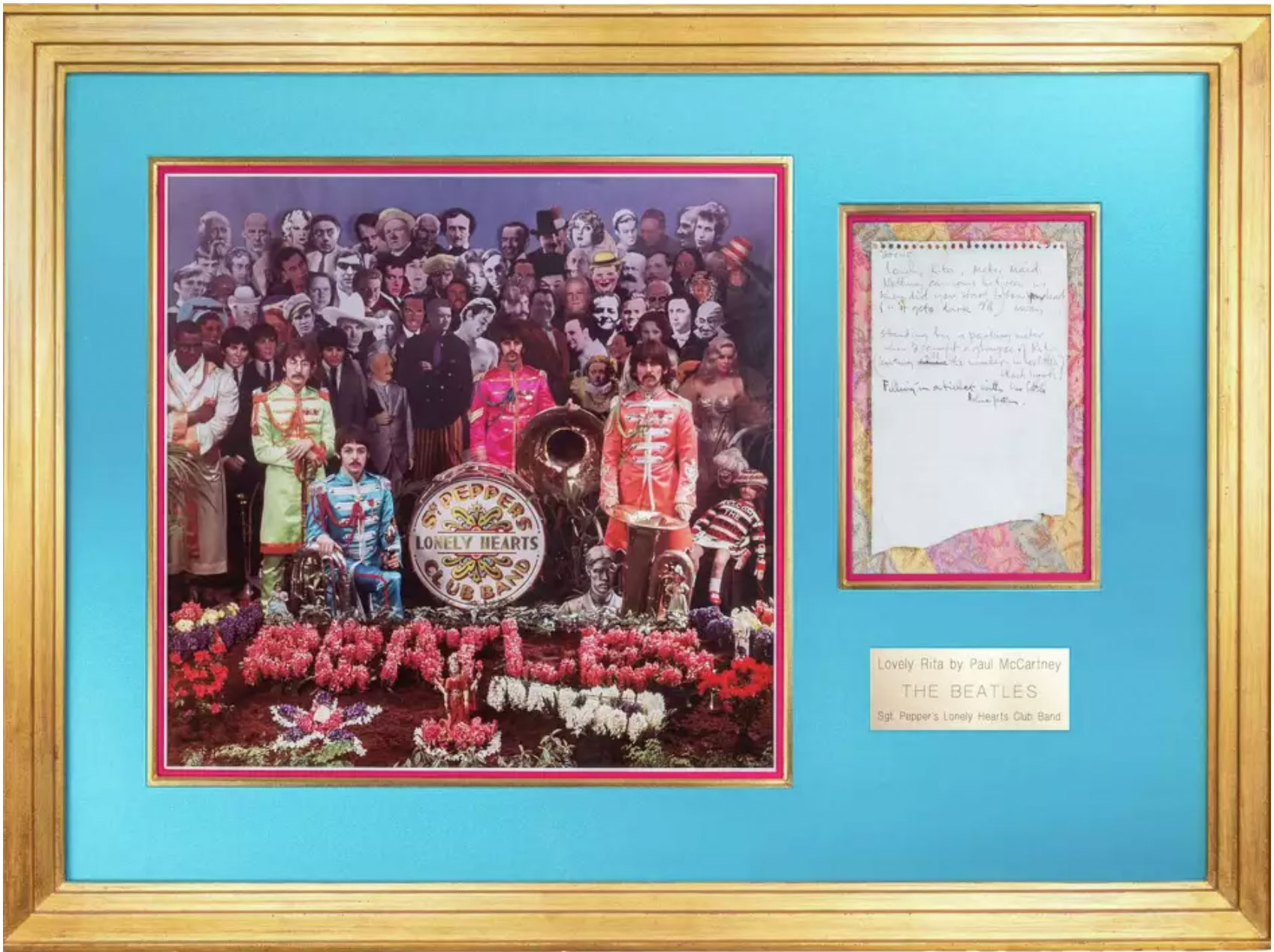
1967. Paul McCartney’s handwritten, working manuscript (as Beatle) for Lovely Rita, from the album ‘Sgt. Pepper’s Lonely Hearts Club Band’, the most famous album in the entire panorama of modern music. This is the very first (rough) draft, 10 lines (in ink), all in Paul’s handwriting and all written on a single side of an irregular scrap of lined paper (7 1/2” X 5”) torn from a spiral notebook. 7 lines in black are Paul’s first concept. 3 lines of changes have been added later in blue, such as, “writing all the numbers in her little black book” changed to “filling in a ticket with her little blue pen” and still later recorded as “filling in a ticket in her little white book.” Near fine condition. Lavishly matted, and framed with a full size, uncorrected, 1st state proof photograph of the album cover, varying in that McCartney is kneeling, the band instruments have been passed around, and 2 people are among the onlookers who would not sign releases, and therefore did not appear on the published album. Ex–Butterfield’s, Dec. 12, 1993. Rare. Icon time. Near fine. Item #245
“Lovely Rita, meter maid, nothing can come between us,
When it gets dark, I’ll tow your heart away...”
Beatles manuscripts from Sargent Pepper held all the rock & roll world records until Bob Dylan’s Like a Rolling Stone sold at auction for $2,000,000 in 2014. But it’s been a while now and another Sgt. Pepper manuscript will take the record back eventually and someday soon the only way to see one will be in a museum, at the end of a long line, behind velvet ropes. The last authentic Sgt. Pepper manuscript at auction (A Day in the Life, admittedly a greater song), sold for $1,202,500 at Sotheby’s in 2010. The last real McCartney manuscript at auction (from another album) was an abridged, later, fair copy of 10 condensed lines from Hey Jude that he wrote out to be used as a key by a backup musician at a recording session ($910,000 at Julian’s in 2020) and that one, in contrast to ours, was not a working manuscript carrying his thoughts, inner debates, and changes.
Offered by Biblioctopus, booth 226.
MARIA MONTESSORI'S MOST IMPORTANT AND INFLUENTIAL BOOK - IL METODO DELLA PEDAGOGIA SCIENTIFICA (The Method of Scientific Pedagogy) - SIGNED & INSCRIBED TWICE TO HER TRUSTED ADVISOR & ATTORNEY, ALFREDO BRUNO. Roma, 1913.
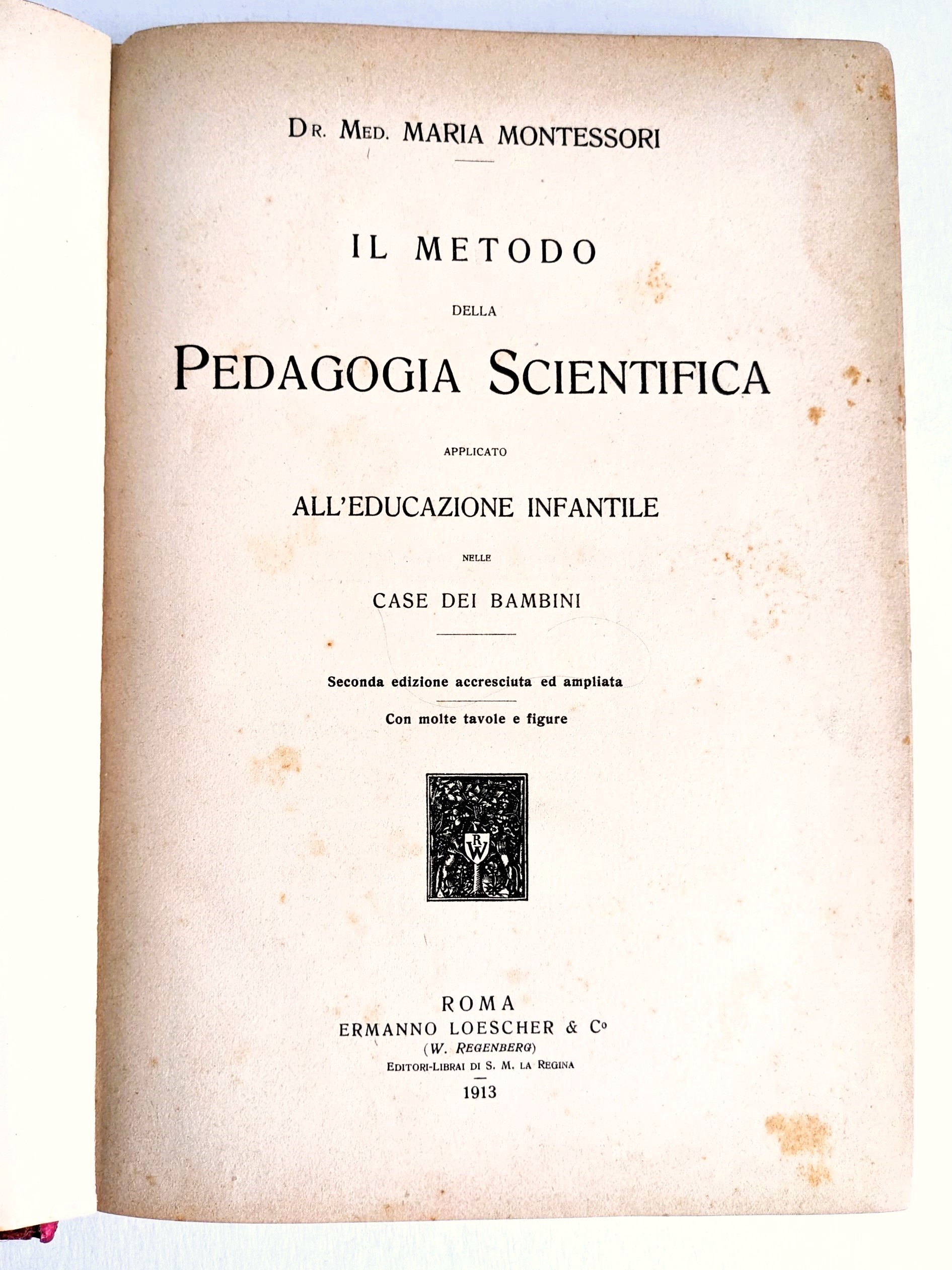
This book established the Montessori Teaching Method and led to the creation of Montessori schools worldwide. $25,000
Offered by Blank Verso Books, booth 207.
Magpie High School Literary Art Journal. Spring 1940 [including James Baldwin's first published short story]
Baldwin, James; Richard Avedon, et al.
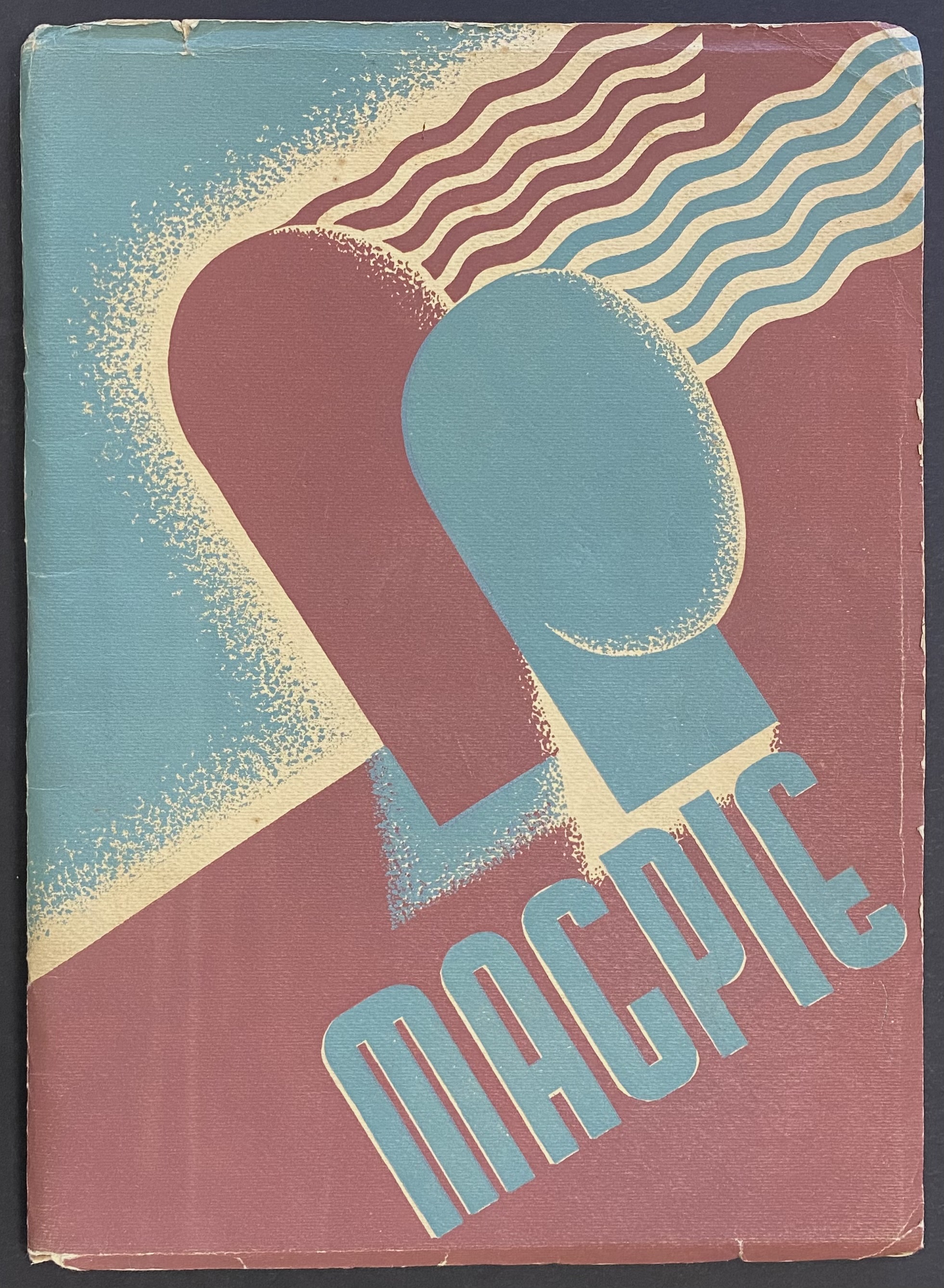
Bronx, NY: DeWitt Clinton High School, 1940. Staplebound. 75p. staplebound literary journal, handsomely produced with illustrations scattered throughout; minor edgewear to covers. Student signature and, ironically, a racist doodle on the title page. 8x11 inches. James Baldwin, then 15 years old, was on the staff of this journal; he contributes the short story “Peace On Earth” (pp. 45-48), apparently his first published fiction (he had previously published a nonfiction essay about Harlem while in junior high school). The story is illustrated by John Baldwin, not related. Another student from the school, future photographer Richard Avedon, also contributes the short story "Early Dusk’" as well as three poems. Price: $2,500.00
Offered by Bolerium Books, booth 247.
Cowper, William. Poems of William Cowper Esq.

London: S.A. Oddy, 1815. 2 Volumes.
Fore edge paintings to each volume, identified in annotations to the endpapers as “Cowper’s House at Weston” and “Cowper’s Residence at Olney” respectively. Fanning the pages reveals charming scenes of village and town life, hidden under the gilt edges.
Octavo. Volume 1: engraved frontispiece, title-page, [v]-xi, [1], [1]-367, [1]pp. 3 additional plates. Volume 2: Engraved title page, [1]-443pp. 5 additional plates. Offsetting from plates, occasional mild foxing. 8.5 x 5.5”.
Offered by B Street Books, booth 157.
Chandler, Raymond
COMPLETE COLLECTION OF STORIES FOR BLACK MASK - 11 ISSUES (1933-1937).
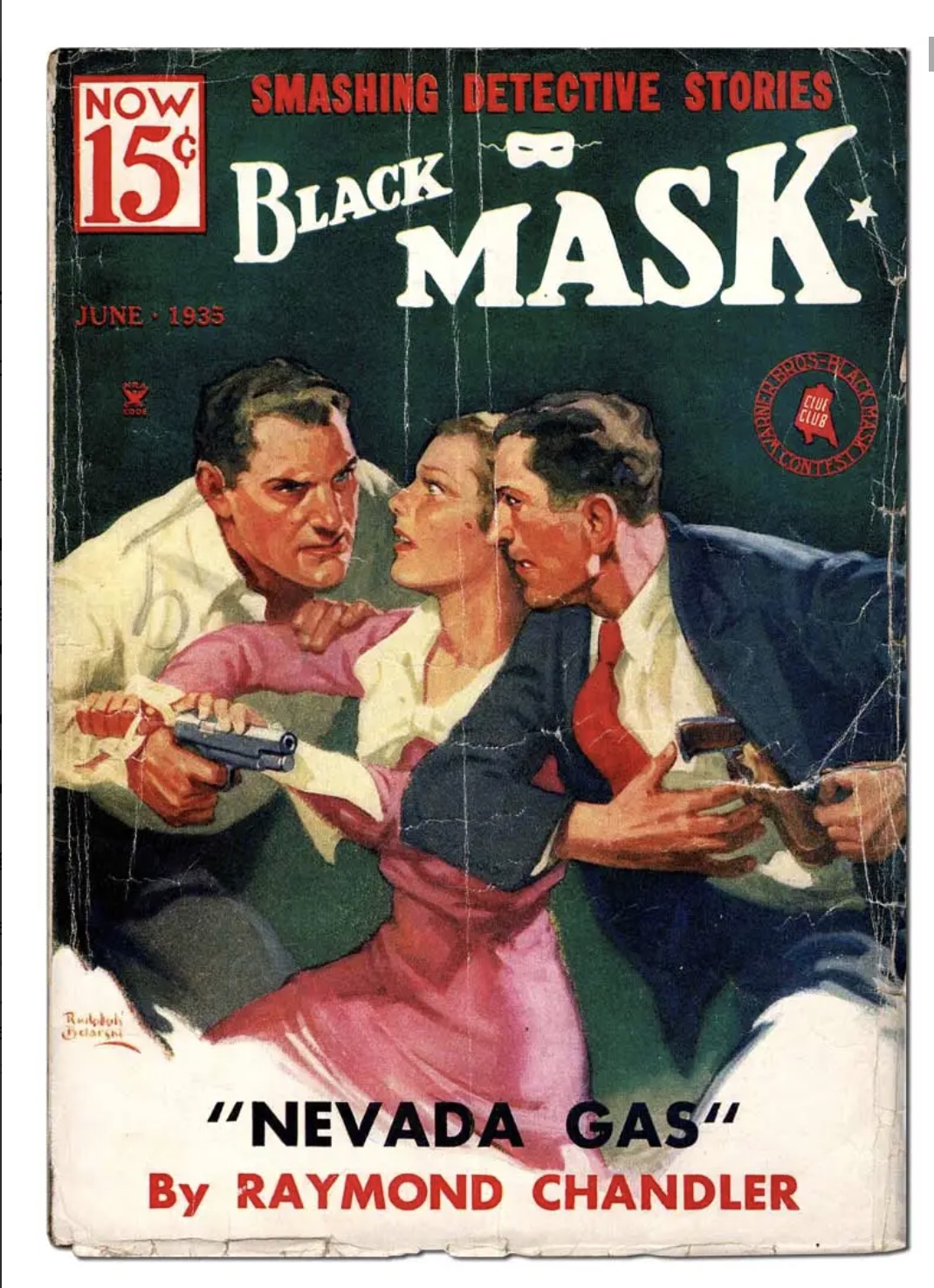
New York: Pro-Distributors Publishing Company, Inc., 1933-1937. First Editions. Eleven small quarto issues (25cm); original pictorial pulp wrappers; illus. Publication sequence as follows: December, 1933 ("Blackmailers Don't Shoot"); July, 1934 ("Smart-Aleck Kill"); October, 1934 ("Finger Man"); January, 1935 ("Killer in the Rain"); June, 1935 ("Nevada Gas"); November, 1935 ("Spanish Blood"); January, 1936 ("Guns At Cyrano's"); March, 1936 ("The Man Who Liked Dogs"); June, 1936 ("Goldfish"); September, 1936 ("The Curtain"); January, 1937 ("Try the Girl"). The December, 1933 issue is a Fair copy, with the text complete, but lacking the rear cover. Remaining issues are Very Good and complete, with some losses to paper at spine ends, six issues with tape (in varying degrees from light to moderate – to spine, covers, cover interiors, and a few opening and closing pages), and small loss to rear joint on the January, 1937 issue.
Raymond Chandler's stories for the pulp magazine Black Mask mark a cornerstone in American crime fiction. Among the hundreds of pulp magazines churning out cheap fiction in New York, Black Mask stood out from the pack; under the watchful eye of editor Joseph T. Shaw, the magazine became fertile ground for top-notch crime fiction written by Dashiell Hammett, Erle Stanley Gardner, Carroll John Daly, Paul Cain, Frederick Nebel, and Cornell Woolrich, to name a few. By Chandler's own admission, he read and studied the stories submitted by Hammett, a man he admired greatly, who "took murder out of the Venetian vase and dropped it in the alley." What Chandler did was take the very best parts of Hammett's writing, and added poetry and style. Perhaps the greatest compliment of his work came from Shaw himself, who declared: "...there was no wordage fat. You could not cut. Every word had to be there." As a testament to their staying power, seven of the eleven Black Mask stories were immortalized by The Library of America in Raymond Chandler: Stories and Early Novels (1995). A perilously difficult set to complete, with relatively few holdings in OCLC member institutions. See: MacShane, Frank. The Life of Raymond Chandler, pp.44-54; Bruccoli C40-47, 49-51; Hagemann 347-357.
Offered by Captain Ahab's Rare Books, booth 148.
The Elzevier Press Petites Republiques 1626-1649.

A complete collection of the 37 titles in the series published in Leiden and Amsterdam, with 14 additional titles by the Elzevier's contemporary collaborators or imitators. A great rarity, recounting the past and present situation of nations and regions of Europe, Asia, the Middle East and Africa, each with a finely engraved title-page.
Offered by Cavendish Rare Books, booth 260.
PTOLEMAEUS, Claudius; translated by ANGELUS, Jacobus, and edited by Nicolaus GERMANUS.
Cosmographia.
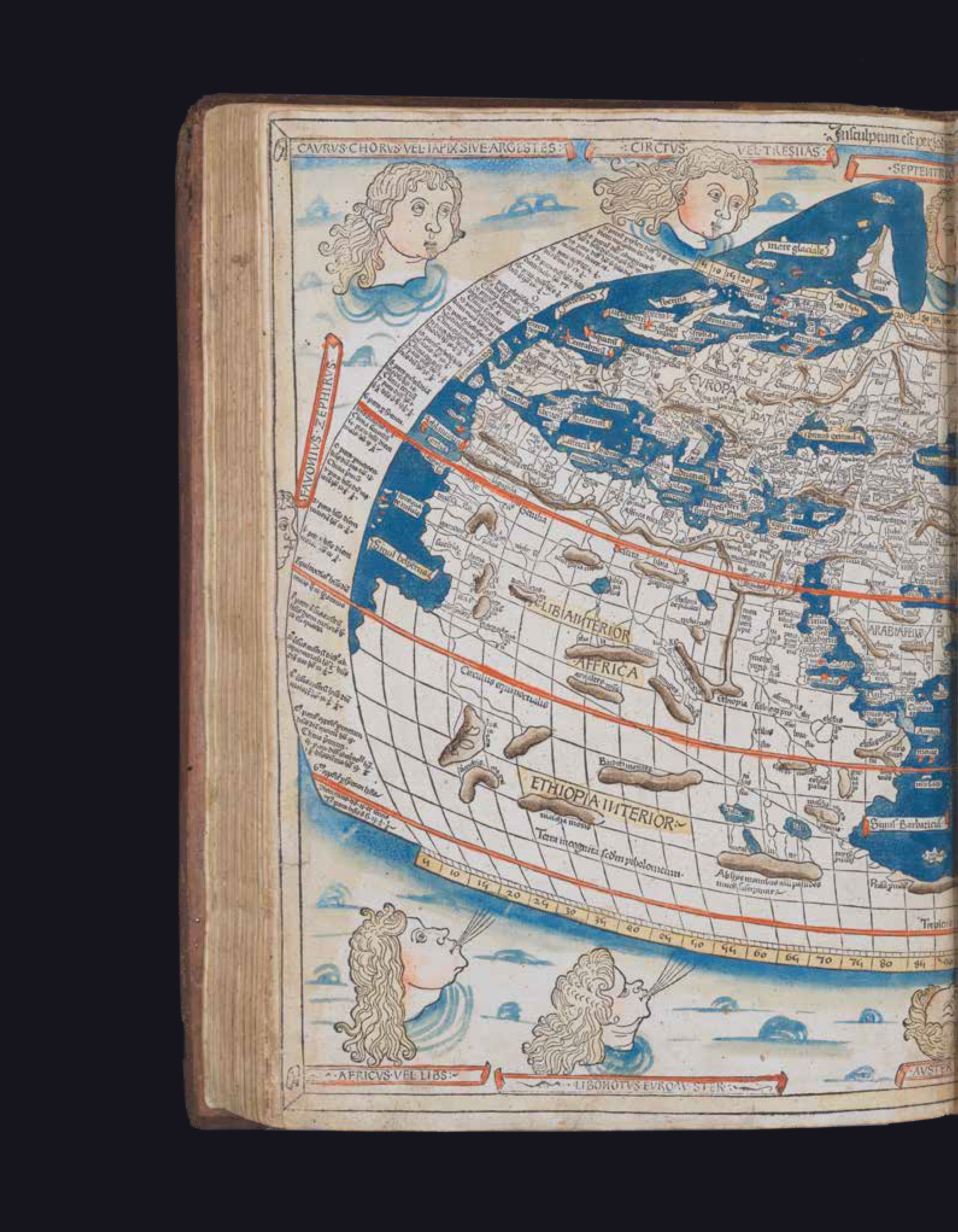
Publication: Ulm, Lienhart Holle, 16 July 1482.
Folio (428 by 310mm), 102 leaves, double-column, 44 lines and headline, Gothic letter, 32 double-page woodcut maps with fine original hand-colour, 4 woodcut diagrams in the text, 2 large illuminated historiated initials, one showing Donnus Nicolaus presenting his book to Pope Paul II, the other of Ptolemy, 159 other woodcut initials coloured in red, green and ochre, paragraph marks and initial-strokes supplied in ochre, tear to d6, and repaired tear to the map ‘Tertia Africa’, some dampstaining and discolouration throughout, including spotting affecting the final three maps, skilful reinforcement to weakened lower page corners on maps, single leaf free endpaper bearing ownership inscription; re- cased in contemporary doeskin over clasped oak boards, joints reinforced with vellum waste, remnants of one clasp remaining.
Offered by Daniel Crouch Rare Books, booth 116.
Nostradamus, [Michel].
Les Propheties de M. Michel Nostradamus. Reueuës et corrigées sur la coppie imprimee à Lyon par Benoist Rigaud 1568.
.jpg)
[Troyes:] [Pierre du Ruau,] 1605. 8vo. First Seve [Vincent] edition. The first edition to contain the 141 Presages [warnings/signs) from the
1555-67 Almanachs and the 58 Sixains (six line stanzas). $2000.00
Offered by Dark Parks Books & Collectibles, booth 129.
1660 Octavo King James Bible with 176 Hand-Colored Plates by the Naval Binder With 176 pages of Hand-Colored Copperplates and a Hand-Written Treatise.
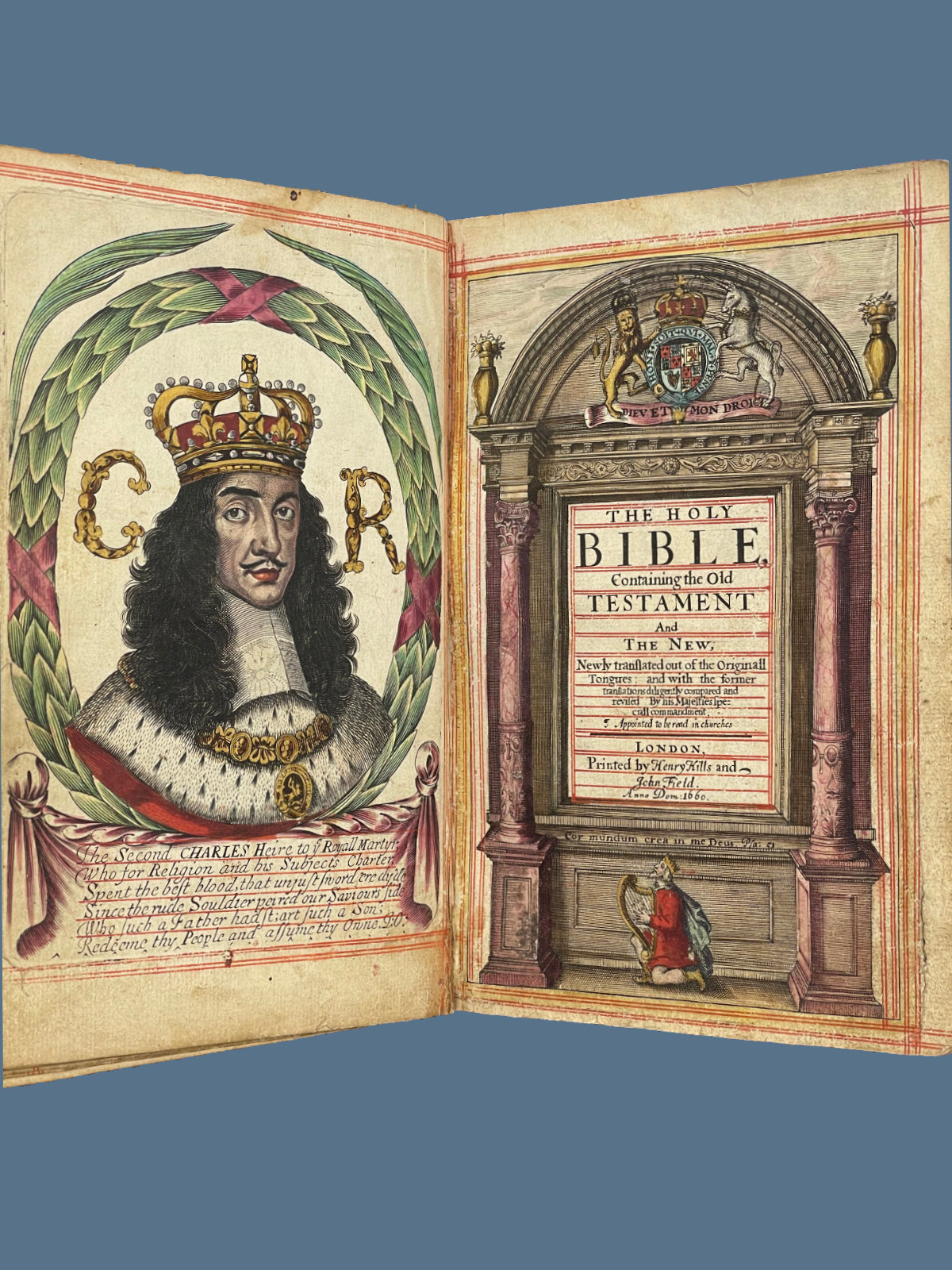
Price: $20,000
Offered by Dungeness Books, booth 208.
THE COUNTER-REFORMATION IN ROME A RICHLY ILLUMINATED, UNRECORDED PRINTING ON VELLUM
Piae et Universalis Confraternitatis Sacratissimi corporis Domini nostril Iesu Christi in Ecclesis domus beatae Mariae supra Minervam de Urbe…
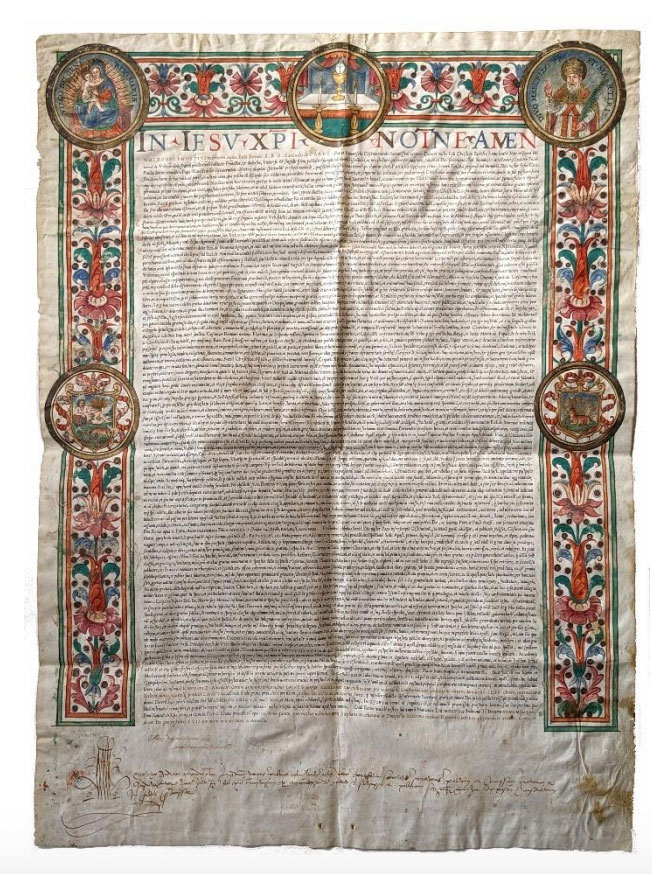
Rome: no printer, 27 June 1559. Single leaf [74 x 54,5 cm], printed on vellum with a handful of manuscript additions in brown ink. Borders richly decorated by hand with floral designs in red, green, blue, and gold as well as 5 large figurative medallions. $8,500
Stunning, large-format broadside intended for limited circulation, probably among the officials of the Confraternity itself. Troubled by the activities of the Lutheran and Calvinist heretics to the north, Paul III needed little persuasion to confirm the initial statutes of the Society of Jesus in September of 1539. Just a few months later (December), he also confirmed the founding privileges of a further non-monastic society: the Confraternity of the Blessed Sacrament, headquartered in the Church of Santa Maria sopra Minerva in Rome. As with most confraternities, few traces survive in print of its early activities. The present document – in which Paul’s successor, Gian Pietro Carafa (Paul IV) re-affirms and revises these founding privileges – thus occupies a significant place in the history of “the most prestigious Eucharistic sodality of the early modern period” (Eisenbichler).
Offered by Editio Altera Rare Books & Manuscripts, booth 149.
Original Cover Illustration Art
THE LEFT HAND OF DARKNESS
by URSULA K. LE GUIN
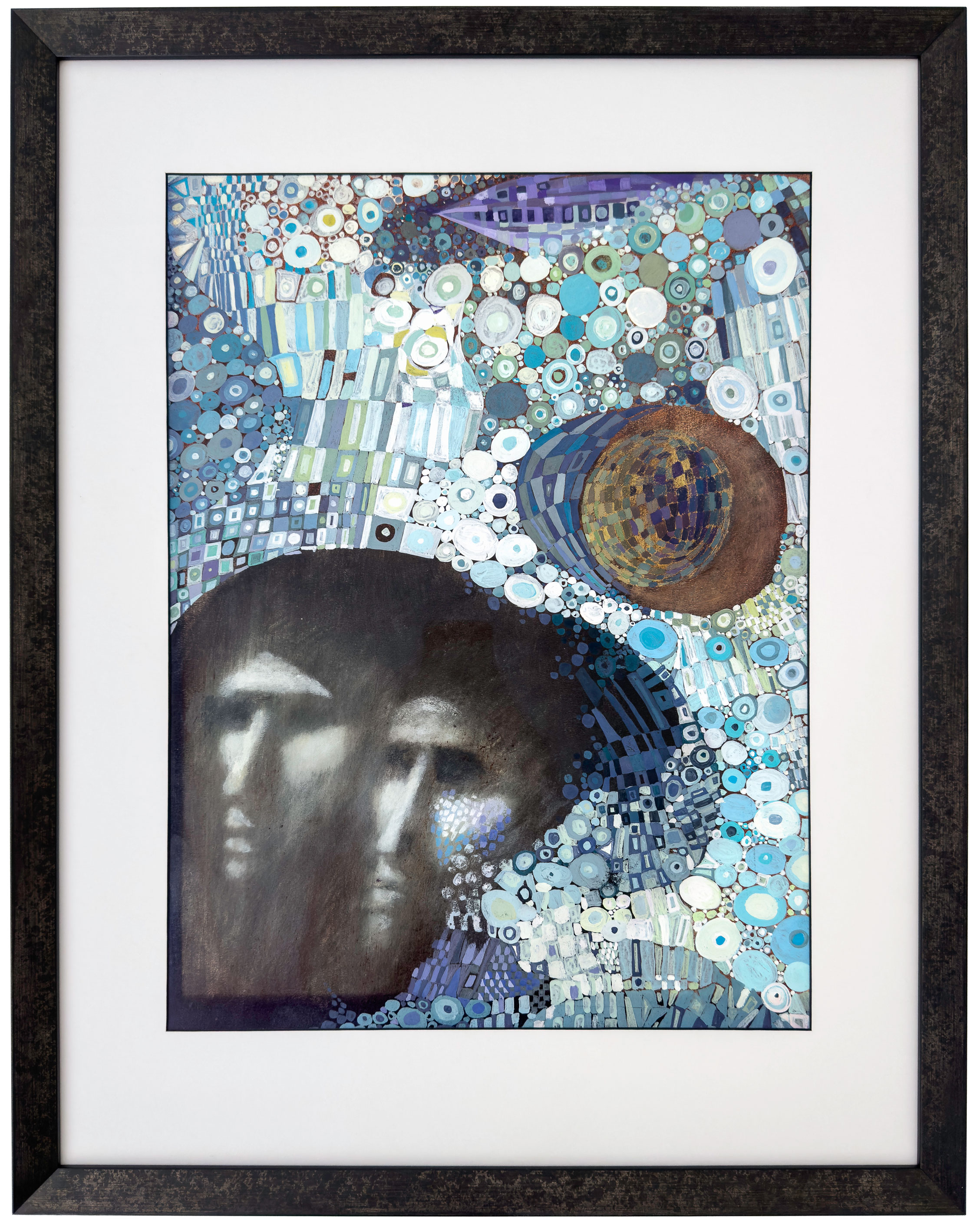
Dillon, Leo and Diane Dillon. Original cover illustration art for the first edition of Ursula Le Guin’s The Left Hand of Darkness.
Le Guin’s The Left Hand of Darkness was one of the first examinations of androgyny in science fiction. The ambisexual individuals on the planet of Gethen are a mirror of what an alternate Earth could be, and the novel explores the effect of sex and gender on culture and society.
Artists Leo and Diane Dillon won the Caldecott Medal in 1976 and 1977. Mr. Dillon was the first African-American to receive the medal. The Dillons’ artwork was influenced by African folk art, Japanese block printing, and medieval illumination.
Provenance: Ace Books gifted the artwork to Le Guin’s editor, Terry Carr, to commemorate the publication success of the book. Owned continuously by the Carr family, the artwork is now offered for sale on behalf of the Carr and Lichtman Estate.
$20,000
Offered by Mark Funke, Bookseller, booth 237.
The Lord of the Rings by J. R. R. Tolkien (1954)

First editions, first impressions, of the greatest fantasy trilogy of the modern era, rarely found in fresh and unrestored condition, as here. Tolkien’s work is one of the most popular and influential works of literature in the 20th century, containing richly rendered detail of a new mythological world, not yet surpassed.
C. S. Lewis wrote of the trilogy that “no imaginary world has been projected which is at once as multifarious and so true to its own inner laws; none so seemingly objective, so disinfected from the taint of an author’s merely individual psychology; none so relevant to the actual human situation yet so free from allegory”. Tolkien, a noted scholar of Old English, conceived the idea for his tales set in “Middle Earth” while in the trenches of the First World War; its immense influence has been felt ever since publication.
This copy of The Return of the King is in Hammond and Anderson’s first state, with the signature mark “4” present on page 49 and lines of text “sagging” in the middle, later corrected; copies in both states were published simultaneously.
3 works, octavo. Original red cloth, spines lettered in gilt, top edges red. With dust jackets (The Return of the King in first state, without reviews on rear flap). £87,500
Offered by Peter Harrington, booth 212.
ALMANACH des marchés de Paris. Étrennes curieuses et comiques avec des chansons intéssantes, dédié à Marie Barbe, Fruitière Orangere. Dessiné gravé par M. Quéverdo.
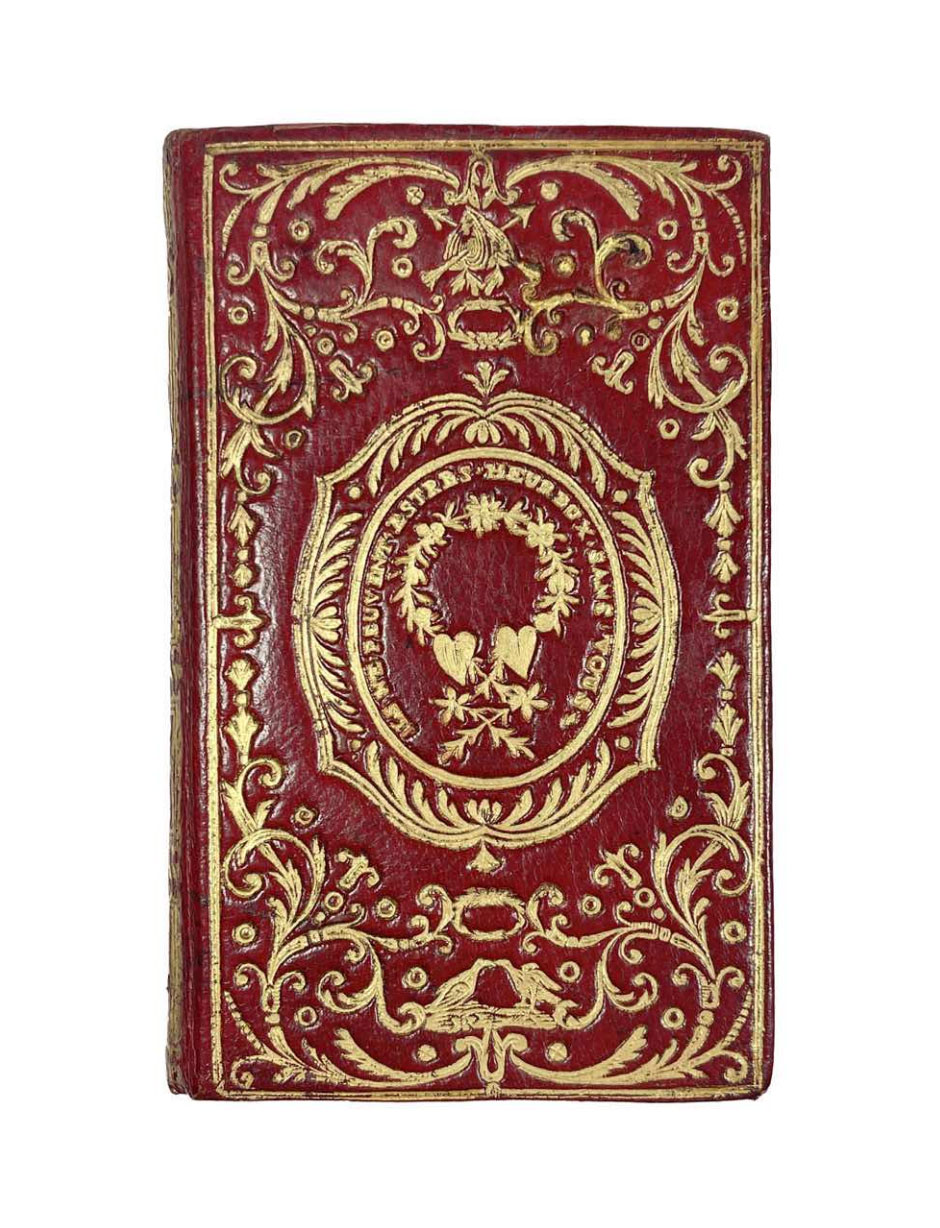
Paris: Boulanger, [1787]. 24mo. Engraved bookplate on the upper free endpaper. [40] engraved leaves, 2 of which are trifold leaves, paginated variously. Contemporary richly gilt-stamped red morocco, spine richly gilt, gilt dentelles, green silk pastedowns, edges gilt. $8500.00
FIRST & ONLY EDITION. The only known copy of this spectacular gastronomic almanac printed in 1787 and bound in a beautiful contemporary binding. Despite its extreme rarity, this almanac series is well-documented in both Grand-Carteret (no. 666 & reproducing two engravings) and Cohen (Guide de l'amateur de livres a gravures du XVIIIe siècle, 1912, col. 20).
After the almanac’s finely engraved title page depicting a street crier who has just tripped and fallen with her fruit – with the ubiquitous exposed breast – there follows a single engraved sheet of important dates for 1787 (e.g. holidays) that has a light blue watercolored background. There are also several other engraved calendar sheets that are for keeping track of ones finances and have the days separated in columns of perte or gain (loss or gain).
The central and most exquisite part of the almanac, however, are the twelve fine engravings of cris de Paris which are each accompanied by a short song about the vendor depicted. The vendors are selling various foodstuffs that correspond with the month and time of the year. Included are oranges, turkeys, fish, flowers, peas, cherries, apricots, cream, melon, sugar, chestnuts, & boudin. There is also one engraving showing Mademoiselle de Chasselas buying goods à la livre (by the pound) at the open market.
On the final leaf is an advertisement by Boulanger for other almanacs for sale with the choice to have them bound in either in leather or silk. The two trifold engraved tables are a twelve month calendar (six months on each) that lists the saints’ days. At the top of each month’s column is a small engraved illustration.
A very fine copy in a lovely binding with the engraved coat-of-arms bookplate of Madame la Vicomtesse Henry de Ségur mounted to the upper free endpaper.
We have had another almanac in this series once before (for the year 1784). It appears that with each year that it was issued, the illustrations are reprinted and then bound with the new calendars for that given year. In the almanac for 1784, the trifold calendar sheets were not engraved but were instead woodcuts with the text printed in red and black. A fine copy.
Offered by Ben Kinmont, Bookseller, booth 217.
Anderson, J[ohn] A[lvin]. [Photo Album Depicting Native Americans at the Rosebud Indian Agency].
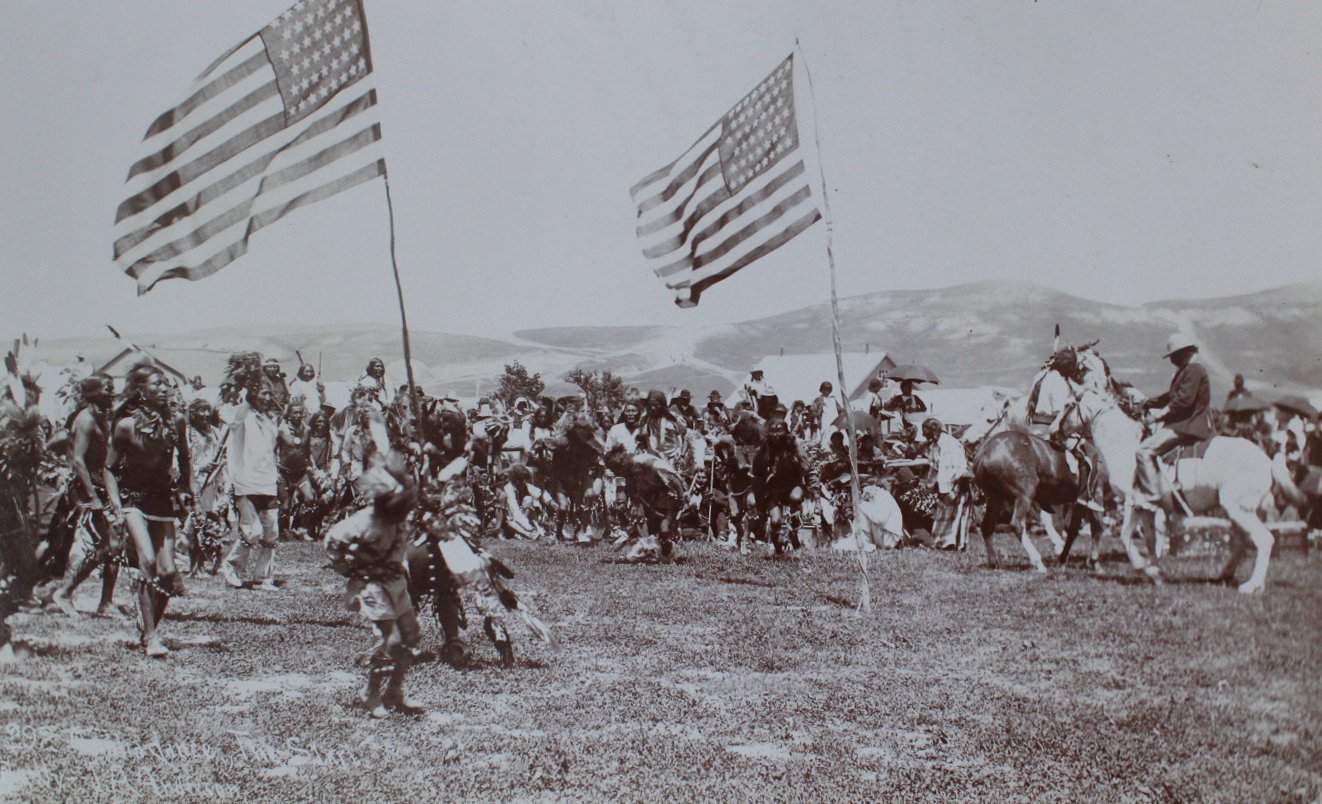
South Dakota: 1889-1893. 6¾” x 11¼”. Steel post binder with contemporary semi-wraparound enclosure made of thick wood boards, held together with a calf backstrip. 25 thick card leaves, most of which are interleaved with typing paper with a total 50 albumen photographs glued down, one per page. Photos measure 4 3/8” x 7 5/8” and 39 are captioned in the negative, though a few are hard to read. Album very good: moderate wear, leaves a bit wavy; photos generally near fine or better.
This is an album of large photographs depicting the Sioux at the Rosebud Sioux Indian Reservation (RSIR, also known as the “Rosebud Agency”) in South Dakota. The album also features some of the early work of an important photographer who dedicated his life to documenting the Rosebud Sioux, John Alvin Anderson.
According to an article by Claes H. Jacobson, Anderson emigrated from Sweden at the age of one in 1870, and his family eventually settled, in 1883, in Sparks, Nebraska, close to the border of South Dakota and near RSIR. (“John Anderson: A Swedish Immigrant and Pioneer Photographer among the Rosebud Sioux Indians” (Swedish-American Historical Quarterly, v. 60, no. 2: Swedish-American Historical Society (April 2009)). John became a carpenter as a teenager and purchased his first camera in the mid-1880s. Per Jacobson, “At this time . . . John became an apprentice to [a local photographer]. Unfortunately, no exact date has been found to confirm exactly when John took his first photographs, but it was probably around 1885.” Anderson also started collecting Lakota artifacts around this time and ultimately spent forty-five years on the reservation. Over that period Anderson built a collection that led to his becoming a museum curator for its exhibition, though he sold the collection to the BIA in 1938. Per Jacobsen, Anderson's
“interest in photography on Rosebud Reservation was an important part of his life . . . there he met daily with tribal members in the store, learned to speak the Lakota language, became close friends with many of them, and developed opportunities to photograph them in his small studio or in outdoor settings. His photographs, taken between the mid-1880s and the late 1920s show not only the Sioux of the past but also what he witnessed of their daily activities in the transitional years.”
Anderson ultimately issued two photobooks on the Sioux, 1896's “Among the Sioux,” and “Sioux Memory Gems,” published in 1929 and including poems from Anderson's wife, Myrtle.
With a few exceptions, all of the photos here depict Sioux and/or their living conditions. Per Jacobsen, Anderson recorded visiting Rosebud in May and June 1889 when the Sioux Land Commission visited for a “Great Council” with General George Crook. Crook then hired Anderson to take photos of Sioux for $20, thereby establishing him as a professional photographer. The few dated photos here show either 1889 or 1893. Jacobson pointed out that Anderson's existing notebooks mention that he was hanging around the reservation's corral and witnessed a slaughter of cattle in June 1889 and that in July he witnessed “Indians . . . dancing all day in spite of the hot weather,” allowing for the inference that some of the undated dancing and allotment photos mentioned below were taken as early as 1889.
According to Jacobson,
“The Rosebud Sioux, or Sicangu Lakota Oyate (Burnt Thigh People), or Brule Sioux, as they are also known, are part of the larger Teton Sioux group who once lived as nomads and hunters on the prairies of central North America from about the 1750s until the mid-nineteenth century . . . by the beginning of the 1880s, the buffalo had been virtually wiped out. The last buffalo hunt of the Sioux took place in 1882 and thereafter a lifestyle and livelihood disappeared. As part of peace treaties between the Sioux and the United States government, the Sioux were forced onto a number of reservations, including the one at Rosebud in south central South Dakota, and the Bureau of Indian Affairs became responsible for providing the Sioux with meat to prevent mass starvation. Large herds of cattle were driven from Texas to the reservations in South Dakota to be slaughtered in corrals . . . Between 1890 and 1915, the Rosebud Reservation was home to some 5,000 Sioux.”
Approximately 15 photos relate to cattle and/or allotments. More than one shows huge crowds of hundreds, if not thousands, of Sioux on horses and with covered wagons awaiting receipt of supplies. One shows several men butchering a steer and there's a great shot of a lone woman with her horse, surrounded by dogs, with the caption, “Sioux Squaw on way home from beef issue.” Another shows a series of tipis in the foreground with the slaughter and issue house in the background, while several show men working with cattle in the corrals themselves.
At least ten show Sioux around their homes. These include a great shot of a woman tanning a hide, while another shows two women preparing a meal. Another amazing shot shows a family sitting outside their tipi with much of their belongings off to one side and what appears to be hides drying on wooden poles.
At least 12 photos depict dances/religious ceremonies. Two of these are captioned “Squaw Dance.” One shows a large crowd watching a single dancer with the caption “War Dance,” another with the same caption shows several dancers. One captions reads “Sioux Indians Dancing the Omaha,” another reads “Scalp Dance,” a third reads “White Buffalo Dance.” There's also a shot of a log and mud structure captioned “Sioux Indian Dance House.”
Other images include the Sioux mounted police force and a great birdseye view of a large swath of the reservation. One, with a caption, “Modern Indian Village,” shows several buildings made of cut logs alongside a few tipis.
The Nebraska State Historical Society has a collection of Anderson Rosebud photographs but they are otherwise institutionally rare and a collection of 22 photos sold at Cowan's in 2020.
Exceptional images documenting the Sioux during a significant time of transition at Rosebudd and taken by a photographer who spent much of his life preserving their culture. $23,500
Offered by Langdon Manor Books, booth 144.
Tosca, Tomás Vicente. Compendio Mathematico, en que se contienen todas las materias mas principales de las Ciencias que tratan de la Cantidad.
Que compuso el Dr. ... presbítero, de la Congregación del Oratorio de San Felipe Neri de Valencia. Valencia A. Bordazar 1707-1715
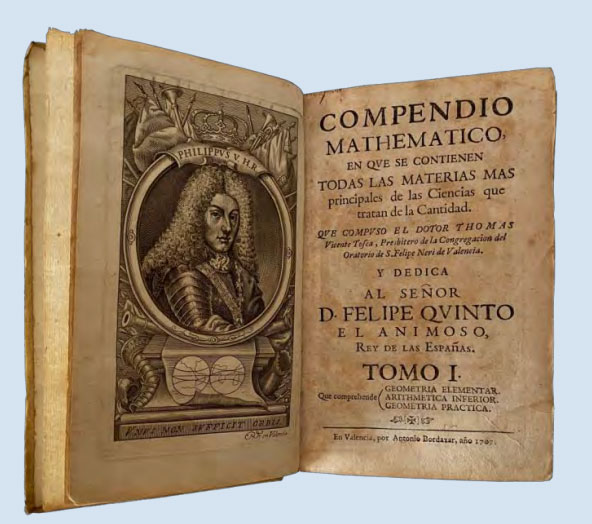
8o, 9 vols. COMPLETE. Fine contemporary vellum. Comprises: I. Geometría elemental. Aritmética inferior. Geometría práctica, 1707, (1) portrait of Felipe V, (6) h., 432 p. (18) folded plates. II. Aritmética superior. Álgebra. Música. 1709, (2) h., 458 p., (5) folded plates., (3) h. III. Trigonometría. Secciones cónicas. Maquinaria. 1710, (2) h., 342 p., (94) h., (11) folded plates IV. Estática. Hidrostática. Hidrotecnia. Hidrometría. 1712. (1) h., 412 p., (11) folded plates, (2) h. V. Arquitectura civil y militar. Montea y cantería. Pirotecnia y artillería. 1712. (1) h., 610 p., 2 h., (35) folded plates. VI. Óptica. Perspectiva. Catroptica. Dioptrica. Meteoros. 1713. (1) h., 542 p., (2) h., (25) folded plates. VII. Astronomía. 1715. (2) h., 576 p., (13) folded plates. VIII. Astronomía práctica. Gegraphia. Nautica. 1715. (2) h., 416 p., (2) h., (10) folded plates. IX. Gnomonica. Ordenación del tiempo. Astrología. 1715. (1) h., 480 p., (3) h., (18) folded plates. A total of 1 portrait & 146 folded plates.
FIRST EDITION OF THIS IMPORTANT AND INFLUENTIAL MATHEMATICAL COMPENDIUM FROM THE 17TH CENTURY. In the panorama of Spanish scientific literature, where the kinematics of Galileo Galilei and Evangelista Torricelli, the perspectives of
Johannes Kepler, René Descartes and Francesco Maria Grimaldi, the atomism of Pierre Gassendi and corpuscular philosophy, and in general the new horizon opened by the scientific revolution had received little attention in printed works, the publication of Tosca's Mathematical Compendium was an important event in the history of European science.
In this work, many of the chapters of the new science are clearly exposed, in the Romance language and from the modern methodological assumptions of Galilei and the mechanistic scientists. Likewise, it represented an attempt to renew the philosophical discourse through the incorporation of modern scientific and philosophical currents.
The nine volumes deal with geometry, geography, nautics, arithmetic, algebra, music, architecture, optics, meteors and astronomy, and scientific instruments, among other scientific subjects.
Regarding astronomy, Tosca's contribution surpasses other previous texts published in Spain and constitutes a good example of astronomical knowledge prior to Isaac Newton. Tosca preferentially uses the Copernican system to explain the movements of the planets. In the geography treatise, he discusses the issue of the movement of the Earth and exposes arguments for and against following Milliet Dechales. WorldCat: no complete copies of this first edition in US Libraries. US$ 17,500
Offered by Librería de Antaño, booth 107.
HOUND OF BASKERVILLES IN THE RARE ORIGINAL PARTS
CONAN DOYLE, SIR ARTHUR
The Hound of the Baskervilles – The Strand Magazine Original Wrapper Issues.
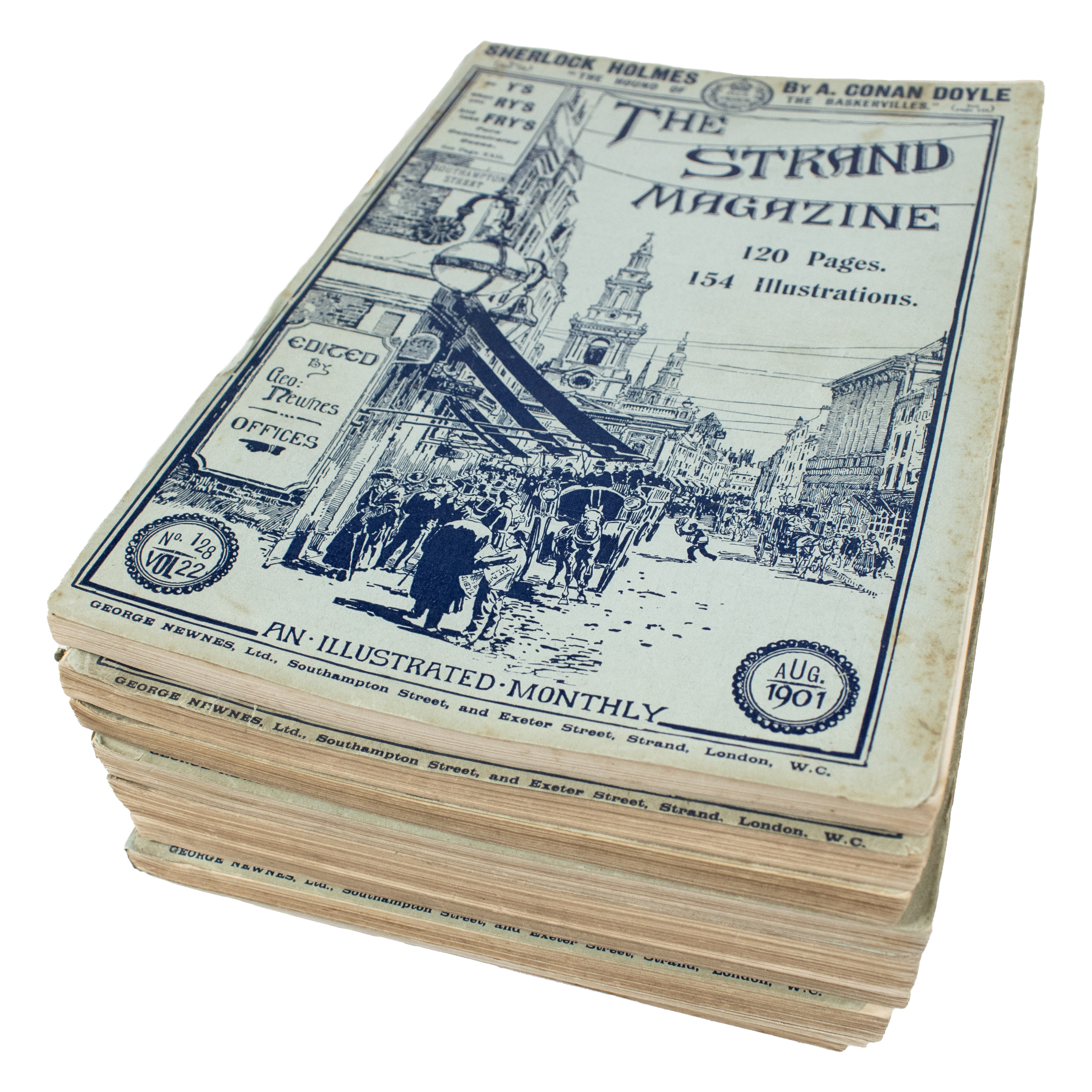
London:George Newnes, August 1901 – April 1902. Numbers 128-136.The Strand Magazine, Original 9 Parts, Complete with all Wrappers and Adverts. With 60 Illustrations by Sidney Paget, by far the most illustrated Sherlock Holmes story.
The Hound of the Baskervilles, Conan Doyle’s best known novel follows Holmes and Watson as they investigate the mysterious demise of Sir Charles Baskerville, whose body is found on the desolate Devonshire moors. One of the most famous crime stories ever written inspired by Bertram Fletcher Robinson (Daily Express correspondent during the Boer War), with whom Doyle struck up a friendship when traveling back on the same ship from Cape Town. On a golfing holiday in 1901 Robinson mentioned the legend of the Black Hound of Hergest associated with the Vaughan family of Hergest Court in Herefordshire. Doyle subsequently relocated his version of the story, with Sherlock Holmes as the main protagonist, to Dartmoor in Devon, Robinson's native county.
Doyle wrote to his mother on 2 April 1901: "Robinson and I are exploring the moor over our Sherlock Holmes book. I think it will work out splendidly... Holmes is at his very best, and it is a highly dramatic idea". In Clam Shell Box.
$20,000
Offered by Marshall Rare Books, booth 126.
The 'Chevalier' Commercial, Pictorial and Tourist Map of San Francisco From the Latest U.S. Gov. and Official Surveys.
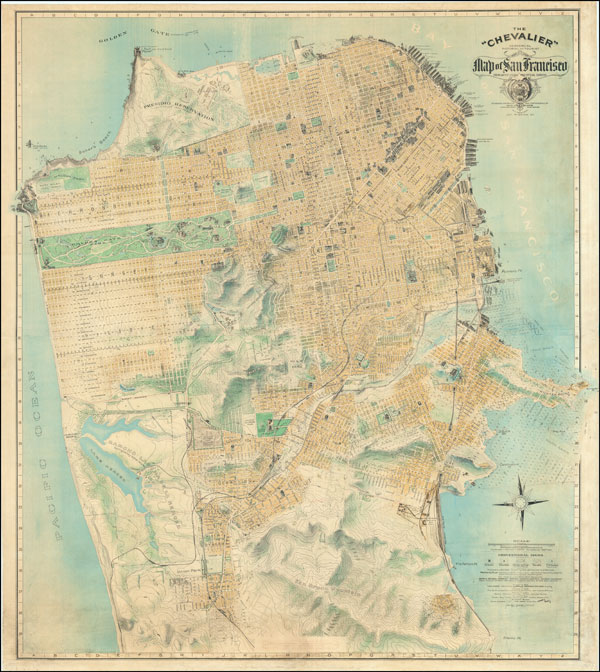
Cartographer(s): Augustus Chevalier
Date: ca. 1911
Place: San Francisco
Dimensions: 54.75 x 62.25 inches
Condition Rating: VG
SKU: NL-01904
The Greatest San Francisco Map Ever Made. Augustus Chevalier's stunning map of San Francisco, the premier map of the city following the San Francisco Earthquake and, by any standard, one of the most impressive and beautiful urban plans in the history of American mapmaking. Published during the re-birth of San Francisco following the 1906 earthquake, Chevalier's map represents the height of cartographic design and chromolithography. With its monumental size and up-to-date urban survey details laid over fine topographical contours, Chevalier has created a sophisticated map with an elegant depth of vision and an abundance of detail. In terms of sheer size and beauty, Chevalier's map belongs to the Pantheon of American Urban plans.
Augustus Chevalier was a native of France who arrived in San Francisco in 1890. He produced his first Commercial, Pictorial and Tourist Map of San Francisco on a much smaller scale in December 1903. The map was very well received, with the San Francisco Chronicle of January 14, 1905, describing it as "The Best Map of the City to Be Had" . . . and offering free copies of the map to advertisers in the Sunday Chronicle.
On July 27, 1911, Chevalier obtained a copyright for a new map of San Francisco, which would be over 5 feet tall, in order to capture in minute detail the remarkable renewal of San Francisco after the earthquake and fire had completely obliterated its prior incarnation. The destruction of the 1906 earthquake and fires provided a proverbial clean slate which allowed entrepreneurial city councilors, urban planners, and businessmen to instigate a series of urban renewal projects that would modernize San Francisco and protect it from future disasters. Chevalier's new wall map of the city captures the re-branding of the city, reassuring investors, citizens, and visitors alike that San Francisco was back, stronger than ever. In doing so, he successfully created a narrative to show how the city had used its worst calamity to renew the very fabric of urbanity, improving everything from commercial and supply infrastructure to public safety. Chevalier's new map received immediate public acclaim in San Francisco, with the San Francisco Board of Supervisors passing a resolution thanking Chevalier for the publication of the map (San Francisco Recorder, August 26, 1911--referencing the smaller pocket map edition). Over the next 4 years, the map was updated at least twice, including an edition promoting the 1915 Panama–Pacific International Exposition. The map was published both as a wall map (this example) and as a much smaller folding map. While
the folding map appears occasionally on the market, only a few examples of the wall map survive.
Offered by Neatline Antique Maps, booth 128.
(BINDINGS - DE SAUTY). RUSKIN, JOHN. OF KINGS' TREASURIES. [bound with] OF QUEENS' GARDENS.
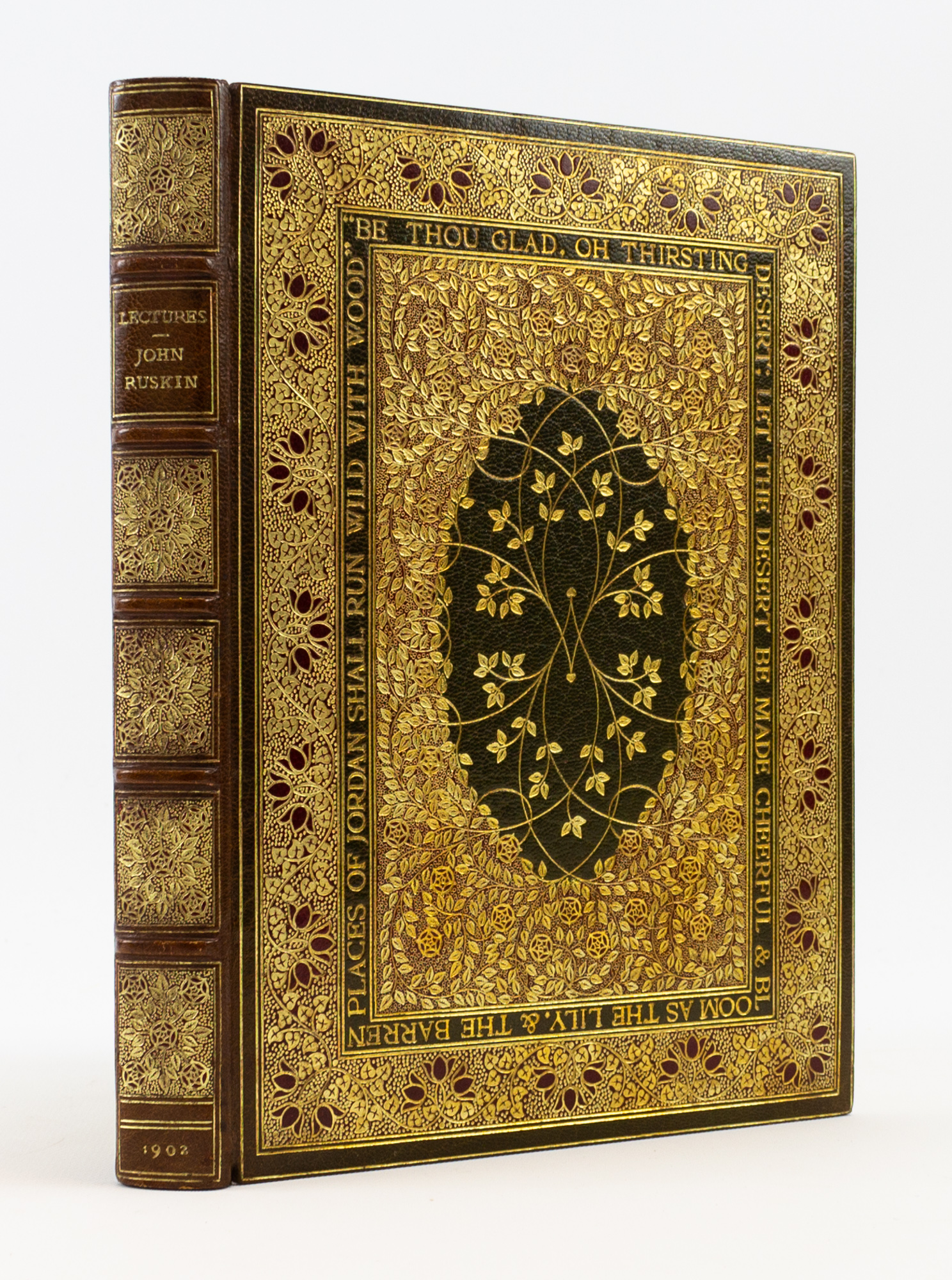
(London: The Ballantyne Press for George Allen, 1902) 202 x 147 mm. (8 x 5 3/4"). 2 p.l., 84, [2], 85-99, [1] pp., 4 leaves (blank); 2 p.l., 68 pp., [1] leaf.
SUPERB OLIVE GREEN MOROCCO, EXQUISITELY GILT, BY DE SAUTY (stamp-signed in gilt on front turn-in), covers with central mandorla decorated with thin gilt lines and leaves, surrounded by a panel of inlaid red morocco almost entirely covered by gilt stems, leaves, and small flowers, and stippled with tiny circles, a thin panel border with words from Isaiah 35:1 beginning "Be thou glad, oh thirsting desert" in gilt, the whole surrounded by an inlaid red morocco border densely gilt with trios of flowers, leaves, vinestems, and stippled with tiny dots, French fillet border, raised bands, compartments gilt with leaves, flowers, and stippled with dots, gilt lettering, gilt-ruled turn-ins, top edge gilt, others untrimmed. Entirety of the main text with complex floral woodcut borders, numerous large and intricate initials printed in red. Front joint with thin crack alongside top three and bottom two compartments (but not apparent, being hidden by refurbishment), spine sunned to honey brown (as usual with green morocco), a couple of instances of faint offsetting internally, but AN EXTRAORDINARILY BEAUTIFUL VOLUME, quite attractive inside, and the binding absolutely splendid.
Covering a wonderful tribute to the author John Ruskin and the Arts & Crafts movement he helped inspire, this is a dazzling binding by one of the greatest craftsmen of the period. The text is composed of two lovely private press editions of Ruskin's famous pair of essays on books, education, and Victorian gender roles. The first work, "Of Kings' Treasuries," is a critique of contemporary masculinity; the second work, a companion piece titled the "Of Queens' Gardens," describes an ideal model of Victorian femininity, in which women restrict their influence to the home and provide moral guidance to their husbands and family. For both men and women, Ruskin promotes reading and proper education as the means to fulfill their ultimate purpose. An eminent critic of art and social issues, Ruskin (1819-1900) had a considerable influence on artistic movements like the Pre-Raphaelites and the Arts & Crafts movement, as well as on social welfare policy. Our copy of these two works was beautifully bound by Alfred de Sauty (1870-1949). A finisher for the Riviere firm at the end of the 19th century, de Sauty subsequently created designs for the Hampstead Bindery and taught at the London County Council School of Arts and Crafts. He later emigrated, becoming manager of the Extra Bindery at R. R. Donnelley Co. in Chicago, where he became known as one of the most accomplished binders at work in the first third of the 20th century. As suggested by the present example, he was a binder with enormous technical skill and a refined imagination for design. Prideaux herself praised De Sauty in her "Modern Bookbindings," saying that "his work is of considerable merit. His inlays are distinguished for the taste shown in the association of colours, and his finishing has some of the brilliant qualities of the French school, seen particularly in the finely studded tooling of which he seems particularly fond." The extraordinary gilding on our binding is in perfect condition, and it is certainly one of the best examples de Sauty's work that we have ever had the privilege of acquiring. $14,500
Offered by Phillip J. Pirages Fine Books & Manuscripts, booth 216.
ACCUM, Frederick.
Culinary Chemistry, exhibiting the scientific Principles of Cookery, with concise Instructions for preparing good and wholesome Pickles, Vinegar, Conserves, Fruit Jellies, Marmalades, and various other alimentary Substances employed in domestic Economy, with Observations on the chemical Constitution and nutritive Qualities of different Kinds of Food, with Copper Plates.
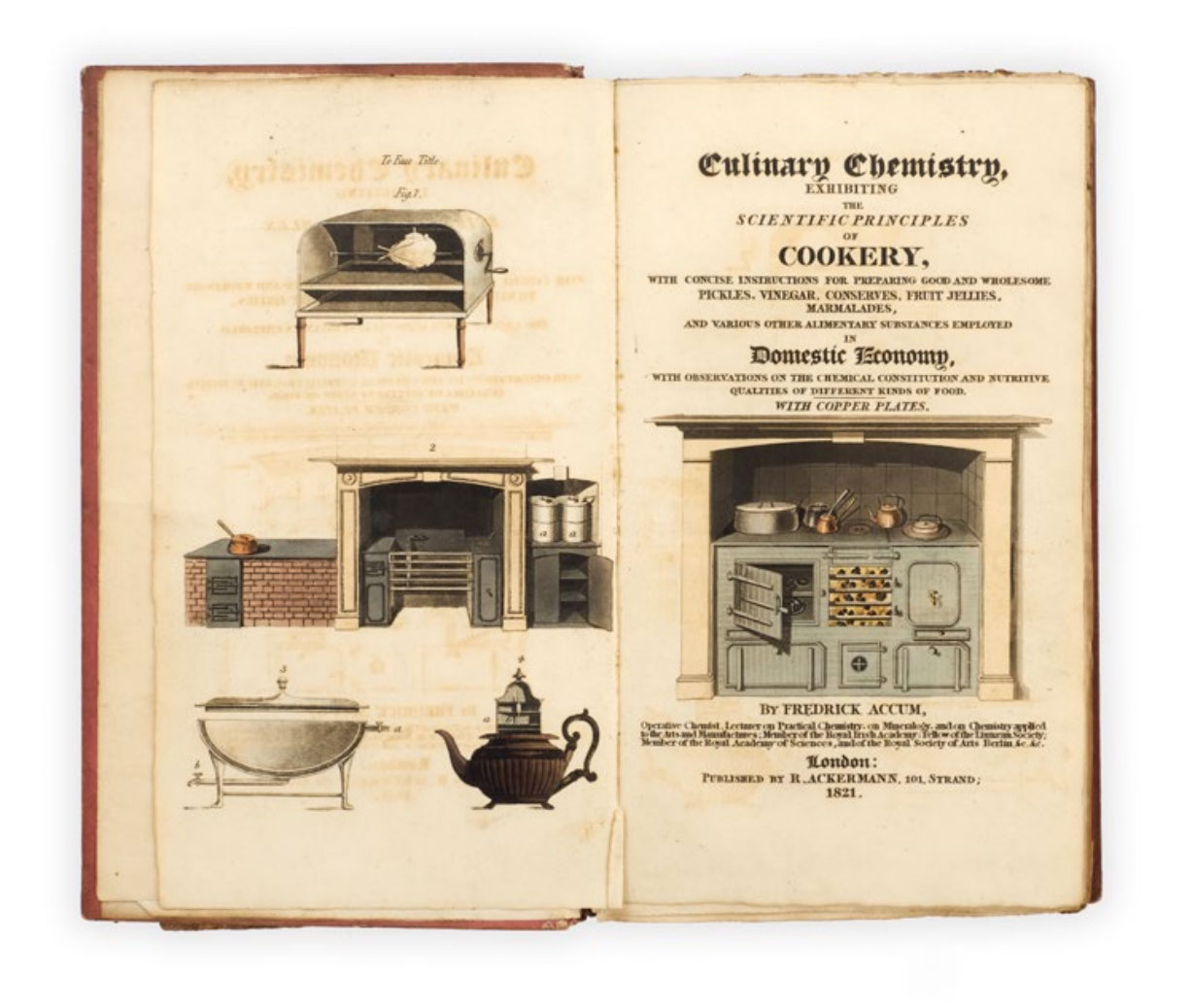
London, [C. Green for] R. Ackermann, 1821. First edition of this early treatise on scientific gastronomy by the apothecary and applied chemist Frederick Accum. The German-born Frederick Accum (or Friedrich, 1769–1838) wrote widely on chemistry, cookery, and poisons in both English and French, alongside lecturing, teaching, and selling chemicals and apparatus from premises on Old Compton Street in Soho. He was an early advocate of and expert in gas lighting, and was responsible for installing lights in Ackermann’s building on the Strand in 1811; it was Ackermann who published the Culinary Chemistry in 1821, shortly after the author had fled to Germany accused of removing leaves from books in the Royal Institution library and been dropped by his previous publishers, Longman, Hurst, Rees, Orme, and Browne. Culinary Chemistry was ‘intended to exhibit a popular view of the philosophy of cookery, to enable the reader to understand the chemical principles, by means of which alimentary substances are rendered palatable and nutritious’ (p. iii). Accum offers advice on cooking accompanied by chemical justifications as well as historical and philosophical comments and references ranging from Pythagoras, Apicius, and Dr Johnson to Hindu, Tartar, and Californian cuisine. Although opening with general principles and providing wide-ranging recipes, Accum focuses particularly on methods of preservation with extensive discussions of pickles, vinegars, conserves, jams, syrups, pastes, jellying, smoking, and curing, as well as passages on tea, coffee, abstinence, and vegetarian cultures. Despite the notice on the title ‘with copper plates’, the work is accompanied only by the frontispiece and title vignette illustrating Accum’s advice on the design of stoves and utensils. The volume is completed by twenty-four pages of advertisements for Accum’s other works, including several reviews of the Treatise on Adulterations of Food and Culinary Poisons.
Offered by Bernard Quaritch, Ltd, booth 219.
Hiroshige, Utagawa. With an introduction by J. S. Happer. Tokaido Yokyo and Narita Dochu: Intermediate Tokaido Stations and Views on the Narita Highway. Complete set of twenty original color prints after the drawings made by Hiroshige.
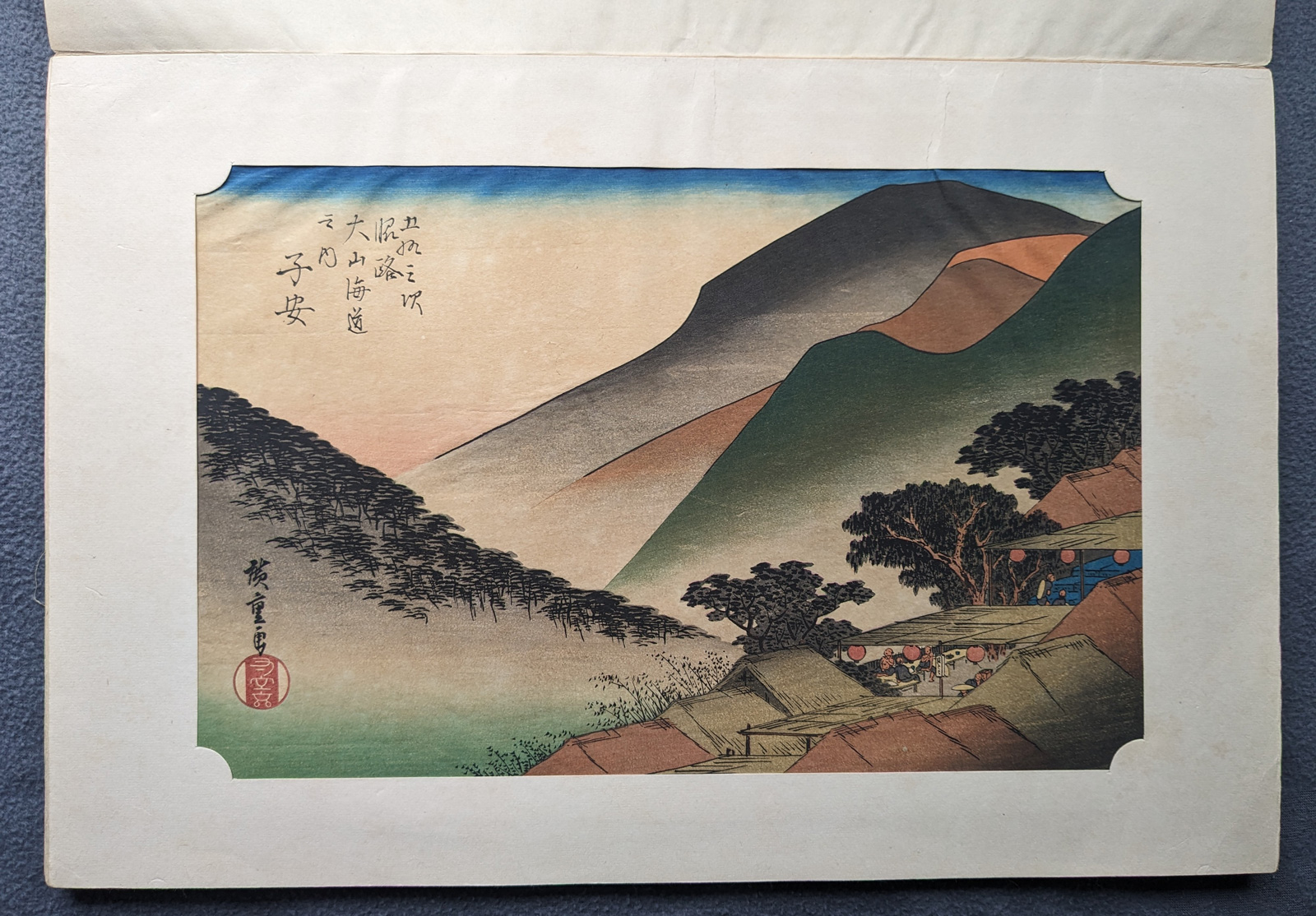
Tokyo, Japan: S. Sakai, 1919. First edition thus. Twenty art prints (complete) with descriptive booklet in portfolio as issued.
The color prints [26 x 38.5 cm] are mounted on thick card stock [31 x 46 cm], with paper matte frames and tissue guards. The images are bright, sharp, and beautiful. Some age toning and light foxing is revealed when viewing at the (unprinted) edges and margins. The prints show extremely well, look bright and fresh, and reveal with excellent contrasts and subtleties. A few of the prints have very small creases or short closed tears near the corners where they are mounted, never interfering with the printed images and there are no paper losses and none which interfere or come near the printed areas. The tissue guards are all foxed, one is missing, and another is detached. Previous owner's faint neat notations in pencil at the bottom of each tissue guard. Overall, the set of prints is complete and in Very Good condition.
The descriptive booklet [31 x 21 cm] is simply side sewn in the Japanese style with turquoise thread. Booklet consists of 15 leaves printed on rectos only [4 pp. in English collated and oriented left to right, 11 pp. in Japanese, likewise, right to left]. The booklet is lightly age toned, bumped at corners, and shows some mellow creasing at the hinge and corners; still Very Good.
Portfolio cloth covered boards [31 x 46 cm] are illustrated with a depiction of Mount Fuji and ocean waves. Paper cover label is printed in Japanese and affixed to the front board. Good only; the front and rear boards are rubbed, lightly stained, soiled, and are detached from one another — but still present and presentable.
A small brochure (perhaps a sales prospectus for this set?) is laid in; it is a single sheet printed on both sides and folded three times like a brochure. This is printed in Japanese in red, blue, and black ink, with four black and white images depicting four of the images from the portfolio. $5,000.00
Offered by Ken Sanders Rare Books, booth 121.
Audubon, John James. The Birds of America, from Drawings made in the United States and Their Territories.
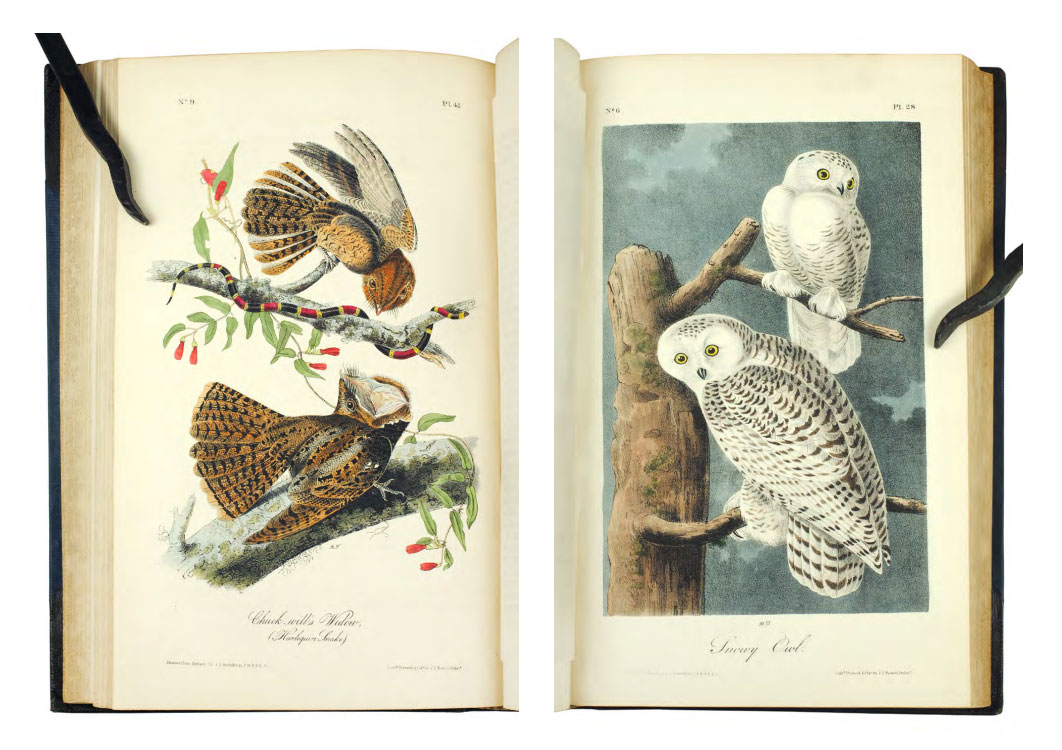
New York & Philadelphia: J.J. Audubon and [vols. I-V] J.B. Chevalier,[1839-]1840-1844. 7 vols, Roy 8vo. 500 hand-colored lithographic plates after Audubon by W.E. Hitchcock, R. Trembly and others, printed and colored by J. T. Bowen. Complete with half-titles, subscriber lists, and indexes.
First octavo edition, containing five hundred superb hand-colored plates. One of the most spectacular series of ornithological prints ever produced and a landmark attempt to document the birds of North America. The royal octavo edition, certainly the most famous and accessible of all the great American color plate books, contained new species of birds and plants not included in the folio edition, with the birds grouped in an orderly scientific manner. The plates, here accompanied by the text for the first time, were reduced and variously modified from the Havell engravings in the double-elephant folio. Seven new species are depicted and seventeen others, previously described in the Ornithological Biography but not illustrated, were also shown for the first time. $79,500
Offered by John Windle Bookseller, booth 231.
For more information about the 2024 California Book Fair, visit https://www.abaa.org/cabookfair...
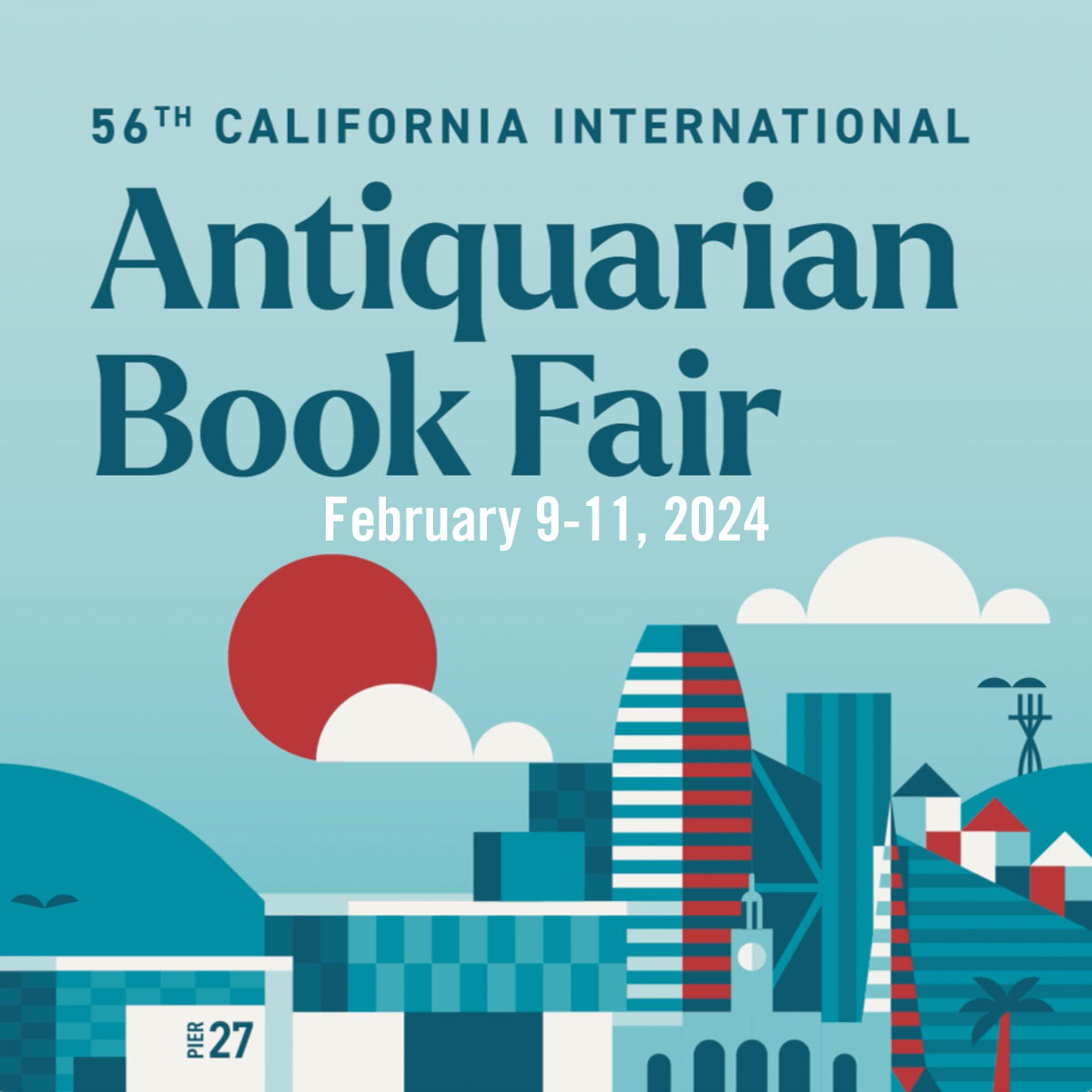


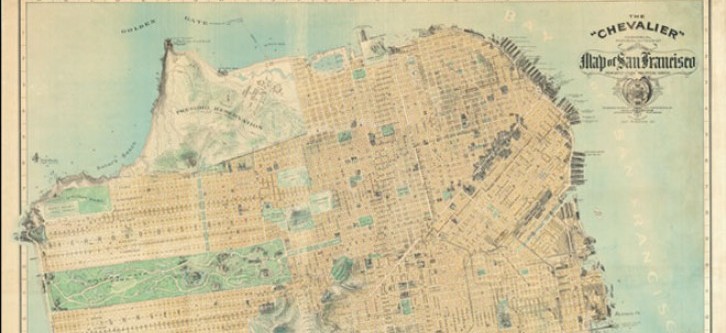










.jpg)













